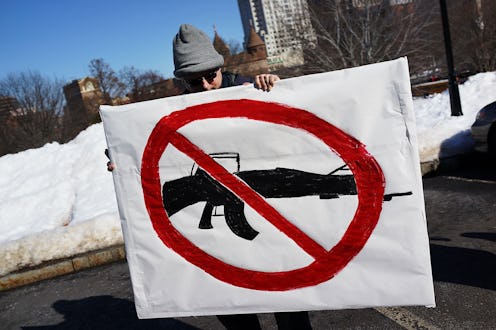News
Gun Injuries Are Getting Worse & Here's Why It's So Harrowing For Young Americans

The gun violence epidemic is often quantified by the number of deaths occurring per year, but a study presented at a meeting of the American Public Health Association in Atlanta on Monday singles out another crucial metric: wound severity. The study shows that gun injuries in the United States have worsened since the 1990s, especially for young adults.
In fact, young adults who were hospitalized for gun wounds saw a 0.66 percent increase in "serious open injuries" — an open injury is one that breaks the skin — between 1993 and 2013. That means that approximately one out of every 150 young adults hospitalized for gun injuries had their wound classified as an "open serious injury" when it might have been less serious the previous year. Young adults also experienced a 0.77 percent decrease in minor injuries. Between 1993 and 2013, the number of "serious open fractures" among all demographics increased by 0.61 percent per year. Minor injuries decreased by 0.74 percent per year.
These harrowing trends are particularly poignant because they were released just one day after a gunman killed 26 people outside of a Texas church on Sunday. And on Oct. 1, an attack at Las Vegas' Route 91 Harvest music festival left nearly 60 people dead and became the deadliest mass shooting in recent U.S. history.
Researchers Yi Zuo and Bindu Kalesan from the Boston University School of Medicine conducted the study using the Nationwide Inpatient Sample, which records data about hospital stays in 44 states. Zuo and Kalesan examined patients who were victims of assault, suicide, legal intervention (meaning injury at the hands of law enforcement, like police officers), unintentional injury, and injury of an unidentified cause.
Dr. Georges Benjamin of the American Public Health Association suggested to U.S. News that the increase in gun wound severity may have two causes: technological development that makes guns more effective at causing damage, and increased availability of the most dangerous weapons. "For example, semi-automatic, assault-style rifles with 30-round mags are much more lethal than a semi-auto hunting rifle with a capacity of five rounds," he said. He did not speculate about why young adults have experienced a particularly steep increase in serious wounds.
The shooter behind the Texas church massacre used a Ruger AR-556 rifle. This gun is an assault weapon — such weapons were banned in the United States until 2004 — and is a model of the AR-15, which was designed off of the M-16 rifle used by the U.S. military.
In addition to murdering 26 people, the Texas gunman wounded 20 others, 10 of whom are still in critical condition. Coverage of gun massacres often focuses on memorializing the dead, but injured victims are also a tragic and important part of these stories. Survivors typically suffer from lasting physical and emotional trauma, as the Boston University School of Medicine researchers noted in a press release.
"The majority of patients with gun injuries will live compromised lives with repeated emergency and hospitalization visits, psychological problems and social challenges," said Zuo. "Simply put, our study demonstrates not only the additional public health burden due to non-fatal gun injuries, but also the direct burden of continued and multiple challenges to the individual."
In other words, victims of gun wounds often require not only immediate but also long-term treatment. Here, too, young adults will find themselves disadvantaged, as they are the least likely demographic to have health insurance. Affording expensive care is particularly difficult for today's young adults: Millennial households are more likely to live in poverty than any previous generation. And a 2016 Harris Poll found that 11 percent of millennials were uninsured at that time and that 16 percent planned to be uninsured in 2017.
If you find this study distressing, don't get discouraged: There are ways you can act to reverse these trends. Demand that your representatives implement better gun control measures, and in the meantime, lend a hand to help the victims of the Texas shooting.